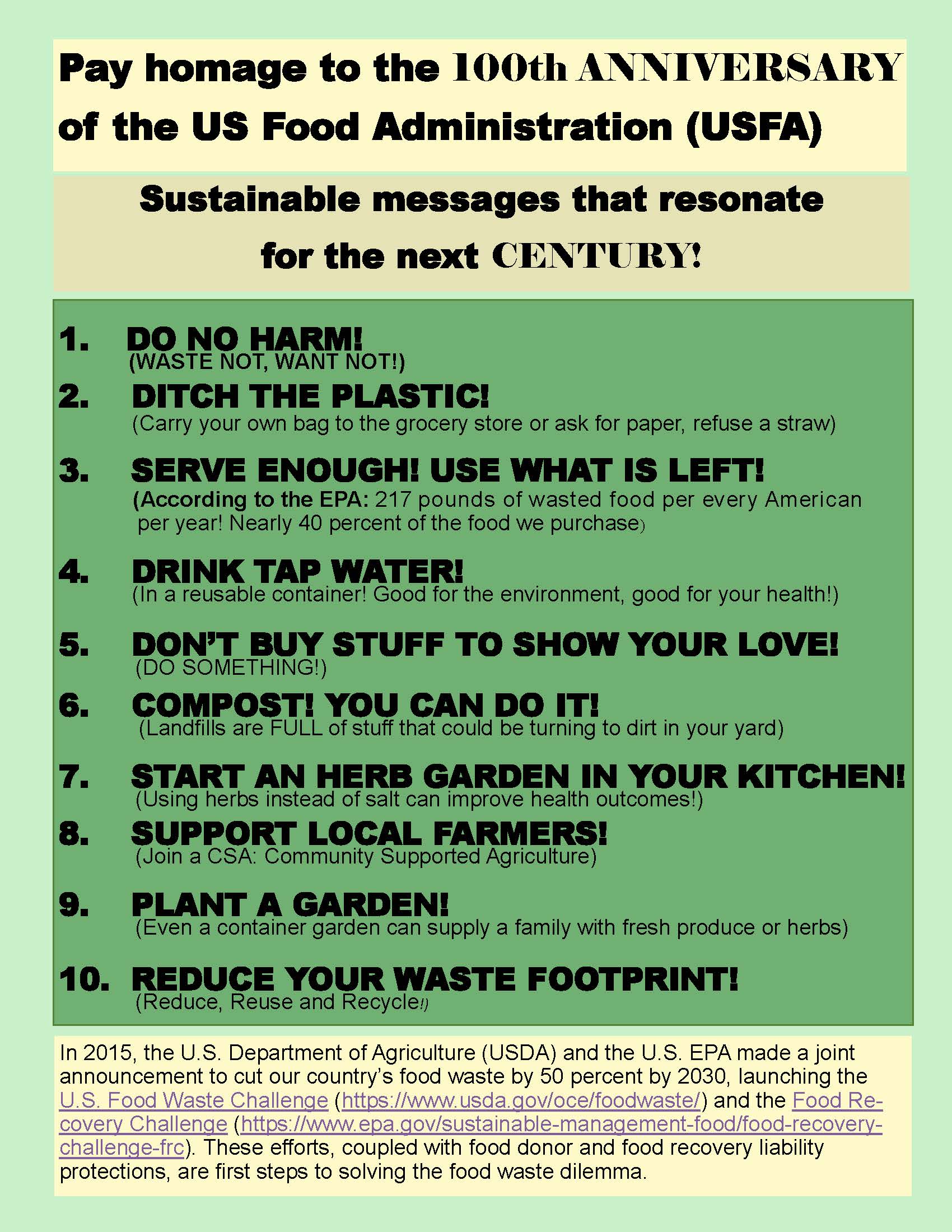
by Heidi Copeland | Mar 2, 2018
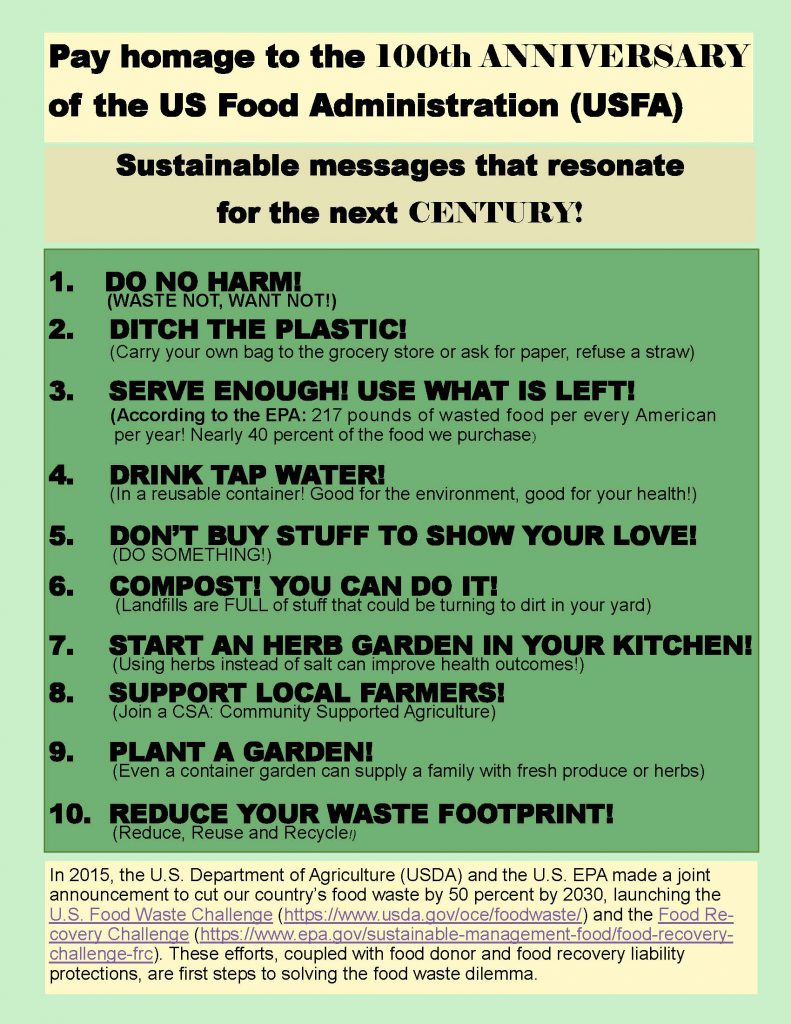
Photo credit: NW Extension District
Sustainability!
According to the Environmental Protection Agency (EPA), the term sustainability has emerged because of significant concerns about the unintended social, environmental, and economic consequences of our world’s rapid growth. Sustainability is based on the simple principle: Everything we need for our survival and well-being depends, either directly or indirectly, on our natural environment. Therefore, sustainability creates and maintains the conditions under which humans and nature can exist in harmony, fulfilling the social, economic, and other requirements of present and future generations.
WHEW! A mouthful, to be sure. Nevertheless, issues of sustainability are often overlooked on the individual level.
Did you know that during the United States’ (US) participation in World War I (from 1917 – 1918), the US had a US Food Administration (USFA) agency? This agency was responsible for food distribution to the US Army overseas and the Allies’ food reserves. This agency also organized a campaign to encourage Americans to support this effort through individual food conservation messages, media campaigns, and food education programs.
Now, 100 years later, this food conservation effort is still applicable.
Everyone can do his or her part in combating waste of all kinds. According to the USDA, reducing consumer-level loss is an important step toward reducing food waste in the United States. USDA estimates that almost 30 percent of the available U.S. food supply was lost from human consumption at the retail and consumer levels.
Every one of us can promote practices to strengthen our natural environment and quality of life. Even the EPA has some suggestions for reducing personal food waste:
- Shop your refrigerator first! Cook or eat what you already have at home before buying more.
- Plan your menu before you go shopping and buy only those things on your menu.
- Buy only what you realistically need and will use. Buying in bulk only saves money if you are able to use the food before it spoils.
- Be creative! If safe and healthy, use the edible parts of food that you normally do not eat. For example, stale bread can be used to make croutons and beet tops can be sautéed for a delicious side dish.
- Freeze, preserve, or can surplus fruits and vegetables – especially abundant seasonal produce.
- At restaurants, order only what you can finish by asking about portion sizes and be aware of side dishes included with entrees. Take home the leftovers and keep them for your next meal.
- At all-you-can-eat buffets, take only what you can eat.
Reducing food waste – a simple action of sustainability. Let’s give it a try! And pay homage to this 100-year-old sustainability campaign that can resonate for the next century.
For more information, visit https://www.usda.gov/oce/foodwaste/resources/consumers.htm and
http://edis.ifas.ufl.edu/fy1134
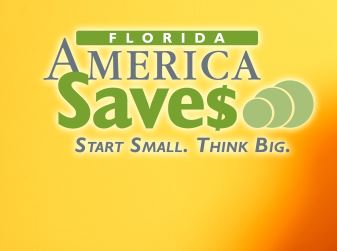
by Judy Corbus | Feb 27, 2018
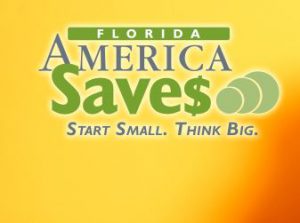
Photo Source: University of Florida
It’s tax time, and many of us will be seeing refund checks soon—time to celebrate!
Now, what are you going to do with all that extra cash?
Maybe you have some bills to take care of, and it’s certainly a good idea to get those off your plate. But after that, let’s say you have some money left over. What then?
Think about putting those extra dollars in a savings account. Or, if you don’t have a savings account, open one. Even if it’s just $100, that first deposit could be the start of a lifelong savings habit.
Which brings us to another question: Why is it important to save?
Let me answer that question with another question: If you had to cover a $1,000 unexpected expense today, could you do it?
These little emergencies come up all the time. Your car needs repairs. You get sick and miss work. You have to travel out of state unexpectedly. These challenges are just part of life, but you can be prepared to meet them.
That $100 you tuck away is not much now, but consider this: If you saved $100 each month for a year, you’d have $1,200 in your bank account. That’s a good financial cushion that can keep you afloat when the unexpected happens.
Need a little encouragement to stick to the savings habit? The Florida Saves Pledge (floridasaves.org) is a great tool for setting financial goals. With this pledge, you’re making a commitment to work toward some type of savings objective, such as an emergency fund, a down payment on a house, or even retirement.
As a Family and Consumer Sciences Agent in Washington and Holmes Counties, part of my job is to help our community members learn to take charge of their money. In fact, there are people like me all over the state helping their neighbors with everything from horticulture to nutrition and youth development. We’re a network of experts who make up the University of Florida’s Institute of Food and Agricultural Sciences Extension. And we’re here to help, today.
For more information, contact your local Extension Office.
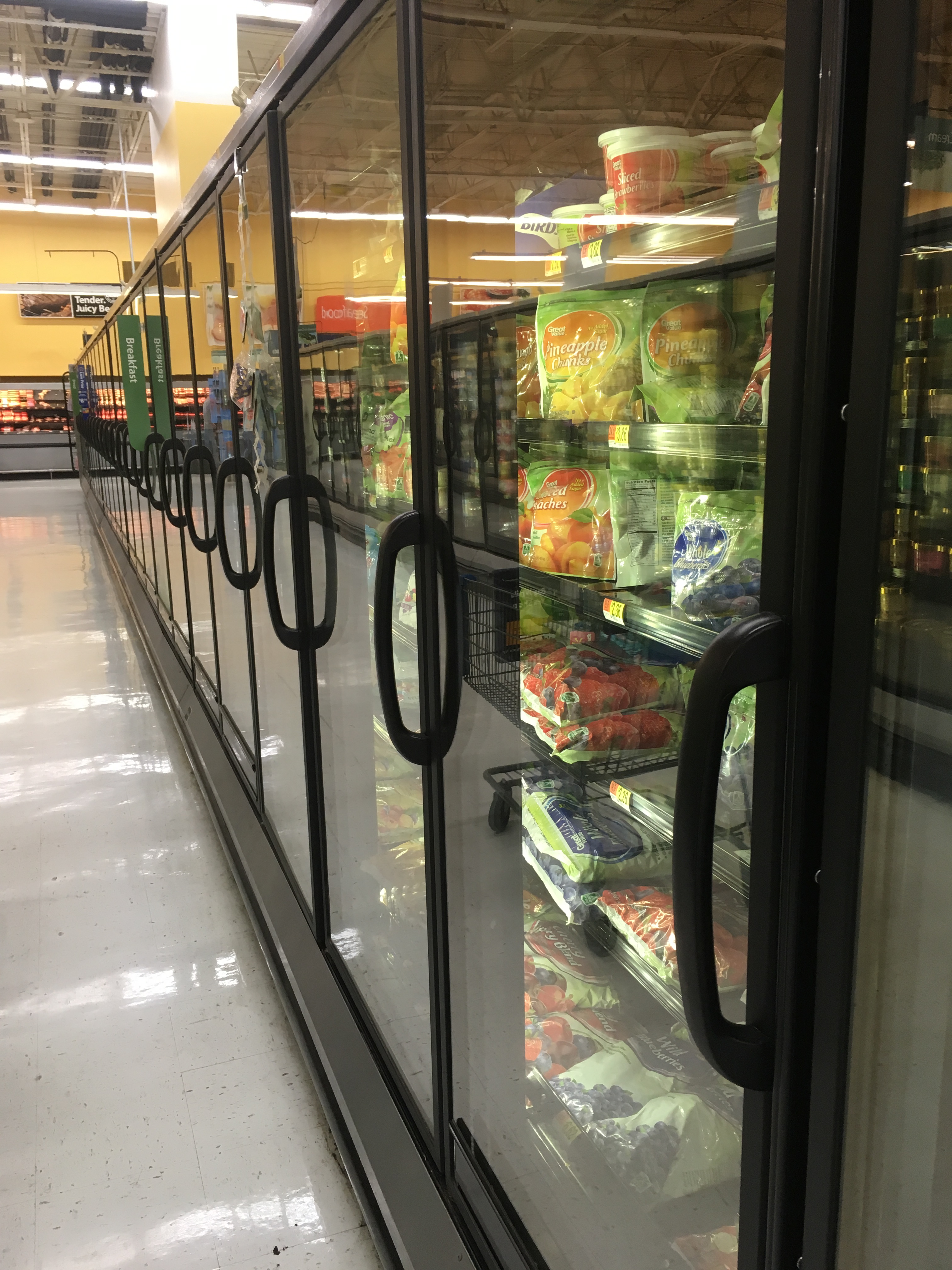
by Melanie Taylor | Feb 26, 2018
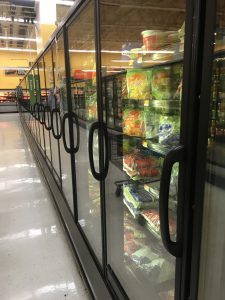 Based on information provided by the American Frozen Food Institute, on average, 40% of all food in the United States goes uneaten and wasted, which is an annual loss of $165 million. Fresh fruit and vegetable waste makes up nearly one-third of this number. With these discouraging numbers and financial losses, how can the frozen food industry help to solve this problem? Frozen food and beverage companies work hard to create the safest and best freezing techniques to keep food safe by preventing microorganisms from growing and by slowing down the enzyme activity that causes food to spoil. Modern freezing techniques have been designed to preserve food at its peak freshness and nutrient content. Frozen food makers continue to work with the U.S. Department of Agriculture (USDA) and the U.S. Food and Drug Administration (FDA) to keep America’s food supply the safest in the world.
Based on information provided by the American Frozen Food Institute, on average, 40% of all food in the United States goes uneaten and wasted, which is an annual loss of $165 million. Fresh fruit and vegetable waste makes up nearly one-third of this number. With these discouraging numbers and financial losses, how can the frozen food industry help to solve this problem? Frozen food and beverage companies work hard to create the safest and best freezing techniques to keep food safe by preventing microorganisms from growing and by slowing down the enzyme activity that causes food to spoil. Modern freezing techniques have been designed to preserve food at its peak freshness and nutrient content. Frozen food makers continue to work with the U.S. Department of Agriculture (USDA) and the U.S. Food and Drug Administration (FDA) to keep America’s food supply the safest in the world.
Freezing means less wasted food and easier access to well-balanced, portion-controlled nutritious foods during every season and in every community. Many times, frozen foods cost less per serving, but most importantly, they have a longer shelf life than fresh or refrigerated foods.
How do frozen foods play such an integral part in the well-balanced, nutritious diets of Americans? The frozen food aisle offers a large variety of vegetables, fruits, and other prepared foods at reasonable prices year ’round. Freezing reduces the need for additives and preservatives. Frozen foods also provide nutritious options that fit into all of the food groups suggested by Choose MyPlate.gov (fruits, vegetables, whole grains, protein, and dairy). They also are a sensible choice when trying to control calories and fat, sugar, saturated fat, and sodium intake. In addition, unused products can be placed back in the freezer for later use.
If you have concerns about frozen foods, it’s time to rethink them. Let’s BUST those crazy frozen food myths swirling around out there!!!
FROZEN FOOD MYTHS VS. FACTS
MYTH: FROZEN FRUITS AND VEGGIES AREN’T AS NUTRITIOUS AS FRESH
FACT: Recent studies found there is no difference in nutrition between frozen and fresh produce.
MYTH: FROZEN FOODS ARE READY TO EAT
FACT: Frozen foods are ready to cook, not ready to eat. As their name suggests, ready-to-cook foods must be cooked or baked according to package instructions.
MYTH: FROZEN MEALS DON’T USE REAL INGREDIENTS
FACT: The freezer aisles of your supermarket are filled with meals made with the highest quality ingredients and prepared the way you would prepare them (if you had the time).
MYTH: FROZEN MEALS AREN’T ENVIRONMENTALLY FRIENDLY
FACT: Actually, frozen foods minimize the amount of spoiled food we throw away because they are already portioned out, so we can take what we need and save the rest.
MYTH: FROZEN MEALS ARE MORE EXPENSIVE THAN RESTAURANT TAKE-OUT MEALS
FACT: Restaurant-inspired entrees like seafood scampi, sesame chicken, and Monterey chicken cost under $4 each. You do the math.
MYTH: FROZEN MEALS ARE NOT A GOOD CHOICE FOR HEALTH-CONSCIOUS CONSUMERS
FACT: “Better-for-you” options are available in the frozen food aisle to make it easier for consumers to control intake of calories, fat, saturated fat, and sodium.
For more information on the frozen food and beverage industry, please visit www.affi.org.
For more information on incorporating frozen foods into your healthy lifestyle, please visit: http://edis.ifas.ufl.edu/fs186.

by Ginny Hinton | Feb 20, 2018
 When there’s a chill in the air, nothing sounds better than a hot cup of coffee or tea. But what are the health benefits and risks of these popular beverages? The answer may be much easier to swallow than you think.
When there’s a chill in the air, nothing sounds better than a hot cup of coffee or tea. But what are the health benefits and risks of these popular beverages? The answer may be much easier to swallow than you think.
Coffee
Americans consume over 400 billion cups of coffee every year. The drink has been blamed for everything from increased heart rate to insomnia – and those may be valid complaints, especially for heavy coffee drinkers. Recent studies give a brighter picture for those who drink a moderate amount. Black coffee has no calories or fat. The caffeine in coffee enhances mood and performance by blocking neurotransmitters that slow brain activity and by affecting other neurotransmitters (i.e. serotonin) that affect mood. In fact, 14 studies with healthy, rested subjects showed improved alertness, short-term recall and reaction time. In addition, coffee contains healthful antioxidants which may lower the risk of stroke and of heart disease in females. Moderate daily intake also helps keep the body hydrated. So, how much is too much? Because caffeine amounts vary among coffees, a maximum of 1/3 to 4 cups per day is recommended, depending on your java of choice.
Tea
On any given day, over 158 million Americans drink tea. There are three main varieties: black, green and oolong, and benefits depend on the type of tea. All tea is full of antioxidants, and the strongest evidence for health benefits is on the side of heart health. Black tea may protect against Type 2 Diabetes and there is some evidence for lowered heart attack and stroke risk. Green tea is a traditional Chinese remedy for headache and depression. It may also help with heart health by lowering cholesterol. Unfortunately, there is no direct evidence for tea being helpful with weight loss. Since typical caffeine levels for tea are less than half that of coffee (20-90 mg compared to 50-120 mg), the recommended maximum range of intake is 1 to 8 cups per day.
That’s the scoop! Enjoy your coffee and tea in moderation, limit added cream or sugar, and you’ll be treating your body well.
References:
Soong, J. (2011). What Counts as Water? Stay Hydrated and Healthy. http://www.webmd.com/parenting/features/healthy-beverages
Caruso, L., Shelnutt, K., Kauwell, G. (August 2014). Hydration Myths. http://edis.ifas.ufl.edu/fy1409.
Ruxton, C. (February 2008). The impact of caffeine on mood, cognitive function, performance and hydration: a review of benefits and risks. Nutrition Bulletin. 33(1): 15-25 http://onlinelibrary.wiley.com/doi/10.1111/j.1467-3010.2007.00665.x/full
Cochran, N. (January 2017). The Health Benefits of Tea. http://www.eatright.org/resource/health/wellness/preventing-illness/the-health-benefits-of-tea
by Laurie Osgood | Feb 7, 2018
What Are the Differences of the Symptoms of a Cold, The Flu And Allergies?
Laurie Osgood, Family and Consumer Sciences Agent, UF/IFAS Extension, Gadsden County, FL
 You’re coming down with something…you have a stuffy nose, you’re coughing and you have a sore throat. Do you have a cold, the flu or seasonal allergies? Because the symptoms can be similar, it is hard to know what you are suffering from. Identifying the differences between symptoms can help you choose the best treatment options. However, you will need to visit your health care provider to know for sure.
You’re coming down with something…you have a stuffy nose, you’re coughing and you have a sore throat. Do you have a cold, the flu or seasonal allergies? Because the symptoms can be similar, it is hard to know what you are suffering from. Identifying the differences between symptoms can help you choose the best treatment options. However, you will need to visit your health care provider to know for sure.
The National Institutes of Health says that the flu and the common cold are caused by different viruses. Colds, the flu and allergies can affect your respiratory system, making it hard to breath. However each condition has key symptoms that set them apart. Flu symptoms can be more severe than cold symptoms and can lead to additional complications. Allergy symptoms can be similar, however they are caused by your body’s immune system reacting to a trigger, or allergen such as pollen, or pet dander.
The National Institutes of Health (NIH) has developed a chart to compare the symptoms of the cold, the flu and airborne allergies. To learn more about these symptoms, visit NIH @ https://newsinhealth.nih.gov/2014/10/cold-flu-or-allergy .
| SYMPTOMS |
COLD |
FLU |
AIRBORNE ALLERGY |
| Fever |
Rare |
Severe and usually high (100˚- 102˚ F) |
Never |
| Headache |
Uncommon |
Common |
Uncommon |
| General Aches, Pains |
Slight |
Usual, sometimes severe |
Never |
| Fatigue, Weakness |
Sometimes |
Usual, up to 3 weeks |
Sometimes |
| Extreme Exhaustion |
Never |
Usually at onset of illness |
Never |
| Itchy, Watery Eyes |
Unusual |
Unusual |
Common |
| Stuffy, Runny Nose |
Common |
Sometimes |
Common |
| Sneezing |
Usual |
Sometimes |
Usual |
| Sore Throat |
Common |
Sometimes |
Sometimes |
| Cough |
Mild to moderate |
Common, can be severe |
Sometimes |
| Chest Discomfort |
Mild to moderate |
Common |
Rare, except for those with allergic asthma |
| Duration |
Can last up to two weeks |
Usually last 1-2 weeks |
Can last as long as allergens are present |
| Treatment |
Get plenty of rest
Stay hydrated
Contact your doctor if symptoms persist |
Get plenty of rest
Stay hydrated
See your doctor for flu treatment options |
Avoid allergens, such as pollen, mold, pet dander, etc.
See your doctor to determine cause of allergic reactions |
| Complications |
Sinus infection middle ear infection, asthma |
Bronchitis, pneumonia; can be life-threatening |
Sinus infection, middle ear infection, asthma |
The best way to prevent getting sick this season is to wash your hands often, avoid close contact with people who are sick, and if you are sick, stay home. There can be severe complications associated with the flu, so get your flu shot each year and contact your doctor if you suspect that you or a loved one has the flu.
To learn more about colds, the flu or allergies, visit the National Institutes of Health at https://www.nih.gov/, or the Centers for Disease Control (CDC) at https://www.cdc.gov/flu/consumer/symptoms.htm
For more information about UF/IFAS Family and Consumer Sciences Program with the Gadsden County Extension, please contact Laurie Osgood at (850) 875-7255.
by Judy Corbus | Feb 3, 2018

Set your thermostat to 68 degrees or lower in the winter to reduce heating costs. Photo credit: Judy Corbus
We have recently gotten a taste of what our neighbors to the north typically experience this time of year – frigid temperatures! As the mercury plummets, utility bills move in the opposite direction. Winter is not over yet so follow these easy steps to save money on your electric bill during the next cold snap:
- Set your thermostat to 68 degrees F or lower in the winter. Dress in layers for added warmth.
- Grab a throw or blanket to stay warm while reading or watching television.
- Check air filters monthly and clean or change when they become dirty. This will help your unit to operate more efficiently and last longer. A clogged filter can cause your heating system to shut down to prevent the compressor from overheating – this requires a service call to reset it.
- Use a ceiling fan, moving in a clockwise direction on low speed, to move heated air down from the ceiling into the living space. Turn fans off when leaving the room.
- Open curtains and blinds on south-facing windows to let the sun naturally warm your house. Close them at night to reduce heat loss.
- Caulk or weather-strip around windows and exterior doors to seal air leaks.
- Insulate water heater supply pipes with foam pipe wrap to reduce heat loss.
For more energy-saving tips, visit My Florida Home Energy.










